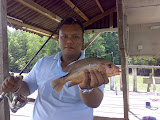Spinnerbait



Safety Pin or Overhead Arm Spinnerbait
The 'safety pin' or overhead blade style spinnerbait is probably the most popular spinnerbait design for bass anglers. Like the in-line spinner, the heart of its' design is a wire that is bent roughly 90 degrees and imbedded in lead shaped like a bullet, along with the single hook behind it.
Blade Options: The rearmost blades is attached by a swivel to a bent enclosed wire circle in the overhead wire's tip. An added blade (ie. tandem spinnerbait)is attached in-line on the wire arm by a clevis ahead of the rear blade the same as for an in-line spinner. The characteristics of blades used that are stated above for in-line spinners, also apply to (overhead arm) spinnerbaits. There is no rule for when to use a particular design, color or size blade,or blade combination, but generally the rounder Colorado blade is used for slower colder water retrieves, dropping the bait in a free fall during retrieve pauses or slow rolling the bait along the bottm. (Slow rolling a spinnerbait is similar to the presentation of a skirted jig that is in contact with the bottom in shallow or deep water.) The Colorado blade helicopters above the weight/hook as the bait drops, thus simulating a dying prey target. Most times the strike occurs as the horizontal retrieve is continued. For more on blade hydrodynamics, see below.
Skirt Options: Like in-line spinners, skirt material options are many and depend on the body/target/action profile desired. Skirts are tied on or attached by a rubber collar to the lead molded on the hook. Typical for bass, silicone skirts have recently dominated the field over(living) rubber skirts because of the molded-in patterns, metal flakes and incandescent colors available. The pulsating, fluttering action caused by blade spin is the same as for in-lines, but the body target is rounder and has more action with the similar retrieve or a pause in retrieve. The skirt also slows the bait down with added resistance depending on how many strands are used, but again, minimum or maximum speed capability is dependent on blade size and shape. The length of the skirt is typically 1/4" past the curve of the hook, but some anglers like longer or shorter skirts depending on profile size and skirt action.
If a bait with a certain style and size blade is retrieve too fast, the bait has a tendency to roll over, ruining the horizontal swim. Ideally, the bait should run true, meaning the overhead arm and blade are directly over the skirt/hook on the horizontal swim.
Trailer Considerations:
Spinnerbait dressings or trailers trailers are even more varied than for in-line spinners and personal preference dominates choice. Shaped pork rind and soft plastic trailers are the norm, with soft plastic being the majority material of trailers used and come in many colors. As with in-line spinners, the trailer affects lure profile, action and lift depending on shape and size. For example, a straight double tail design has the least lift or drag and is more of a skirt-like extension; whereas a large curl tail grub produces the most rear action, lift and the largest profile within the pulsating skirt. Pork or soft plastic chunk baits offer the most lift and allow a planing of the bait on the horizontal retrieve.
Wire Arm length Consideration:
There are spinnerbaits that have a short overhead arm and are used for more vertically dropping presentations down steep structure (banks or points). The have a little less weed resistance than the larger overhead arm and blade, but fall better and are closer to the skirted jig versus the spinnerbait design in useage. Typically a Colorado blade is used to slow the fall and create the maximum fluttering flash on the way down.
Long arm baits are used when a bait has multiple blades or when more weed resistance it needed during a horizontal swim. Single large blades allow for maximum skirt and trailer pulsation and provide added lift to the bait on the slowest retrieve. Long arm baits are typically used to cause a surface wake (ie. waking a spinnerbait) when run near the surface or buzzing when the blades chops the surface into a bubbly, noisey trail. For bass, the target hit is usually the skirt and/or trailer; for northern pike, musky and pickerel, the entire bait may be engulfed.
Stinger (trailer hook) option:
Adding a single or treble hook (a stinger hook) to the main hook is also a personal preference and may ensure a better hook up as well preventing fish that jump from throwing the bait. Some anglers prefer the single hook to be rigged so that the point is down, others prefer it rigged up, but in either case the hook must be prevented from coming off the main hook or grabbing weeds. To accomplish this, there are a few choices. The first is to use rubber tubing cut to 1/8", inserting the eye of the trailer hook and forcing the main hook through the rubber covered eye. The trailer hook is now fixed stationary behind the main hook. The other way allow the hook more side to side motion and consist for stops above and below the eye placed on the main hook. These stops can be 1/8" cut rubber tubing or plastic circles cut from the plastic lid of a coffee can and placed above and below the hook eye encircling the main hook.










1 comments:
kau check ni http://www.nuffnang.com http://www.advertlets.com http://www.sellingppp.com/a.cgi?ppp=1211026533 atau http://www.sellingppp.com
dan daftar
Post a Comment